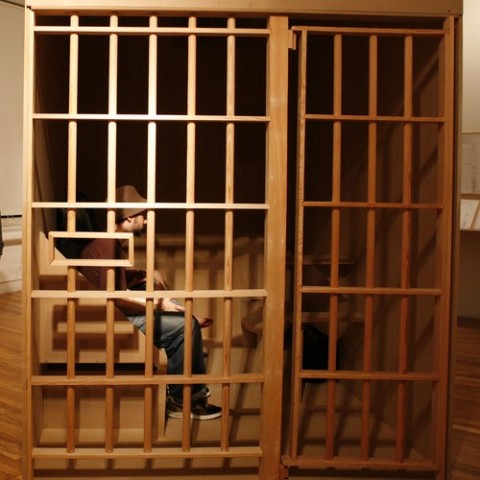Herman’s House, a documentary by Toronto filmmaker Angad Singh Bhalla, will be premiering at the 2012 Hot Docs film festival.
The film documents the symbiosis between a prisoner and an artist. Jackie Sumell is a New York artist aching to make her political art more immediate, and relevant. Herman Wallace is a convicted bank robber sadly distinguished for having spent more time in solitary confinement than any other prisoner in America.
Before connecting with Herman, Jackie’s life was taken up with conceptual political art such as collecting women’s shaven pubic hair to protest the policies of George Bush. But now her magnificent obsession is to build a house that he imagines in his confinement.
The project begins with her building an art installation consisting of his solitary cell replicated in scale. The film’s opening scene is of her sanding down a wooden replica of his toilet. When displayed as art, the claustrophobic confinement of the cell is painfully real. A scene where his sister tries to find a comfortable position to endure a few moments in the cell is especially poignant.
The fact that a human being has been kept in such confinement for 40 years becomes suddenly, and evidently, monstrous. The fact that these conditions are the result of his Black Panther activism are a painful reminder that cruel and unusual punishment is reserved for political prisoners in American jails.
Herman’s House follows Sumell’s experience of trying to make Wallace’s dream house a reality. She moves to Louisiana to be near Wallace in that state’s infamous Angola penitentiary. Wallace himself narrates the film in telephone calls from prison, but is never seen. This is very effective for it emphasizes that he is locked so far down into Americas penal system that he America’s living disappeared. Sumell is his soul existent outside incarceration. But even his dream house is an expression of the damage that a lifetime of incarceration has done to him. When the computer aided design drawings for his dream home are interpreted by various architects, it is apparent that he is designing a luxuriant prison in his mind. Even his imagination has been locked down.
But that does not mean that Herman Wallace is a broken man. His encounter with Black Panther politics in prison has awakened in him a political consciousness that is tantamount to a zen state. He is able to offer comfort to his artist soul sister, and his actual sister when life on the outside, and its injustice, weigh heavy on them. Yet he is the one that should long ago have been driven to madness by his cruel and unusual circumstance. The strength of the man, and his clear eyed acceptance of his situation, defies the imagination.
When Sumell returns to her own childhood home we are given an insight into the source of her obsession. Althought it appears the ideal suburban home, it was a living nightmare for the young artist. Her father was The Man and the dream home held violence and disillusion for her. She unlocked her cage with art. And that is the medium she is using to free the part of Herman Wallace that no cage can contain.
The film suffers occasionally from slow editing and slightly cheesy graphics. But this is just part of the democratization of the filmmaking process. With the means of production being available to anyone with a good idea, you will often get amazing work from people without a Hollywood budget. To deny oneself the experience of this film for these reasons would be tantamount to having refused to watch the Sex Pistols because they were not the best instrumentalists.
Rarely will you see a film more genuine in its human connection between protagonists. This is especially true because of the fact that one of them is so deep in the belly of the beast that he is no longer even visible. The fact that a human connection can be woven between such disparate solitudes is one of the most heartening and real cinematic documentary experiences that one can have.
Herman Wallace could easily have been buried alive in the Louisiana penal system and never heard from again. Jackie Sumell could easily have lived out her days in relative obscurity doing barely relevant political art. But their relationship is testament to the human need to connect and elevate. The film seems to refute everything lie ever told about individualism and to verify everything about the transformative power of love and connection.
Humberto DaSilva is a union activist whose ‘Not Rex Murphy’ video commentaries are featured on rabble.




